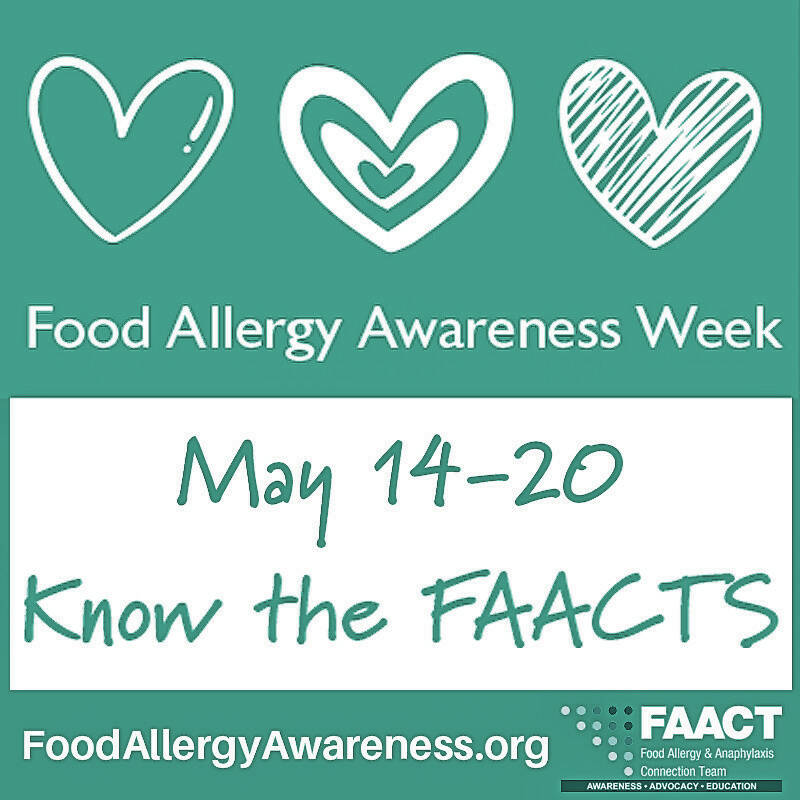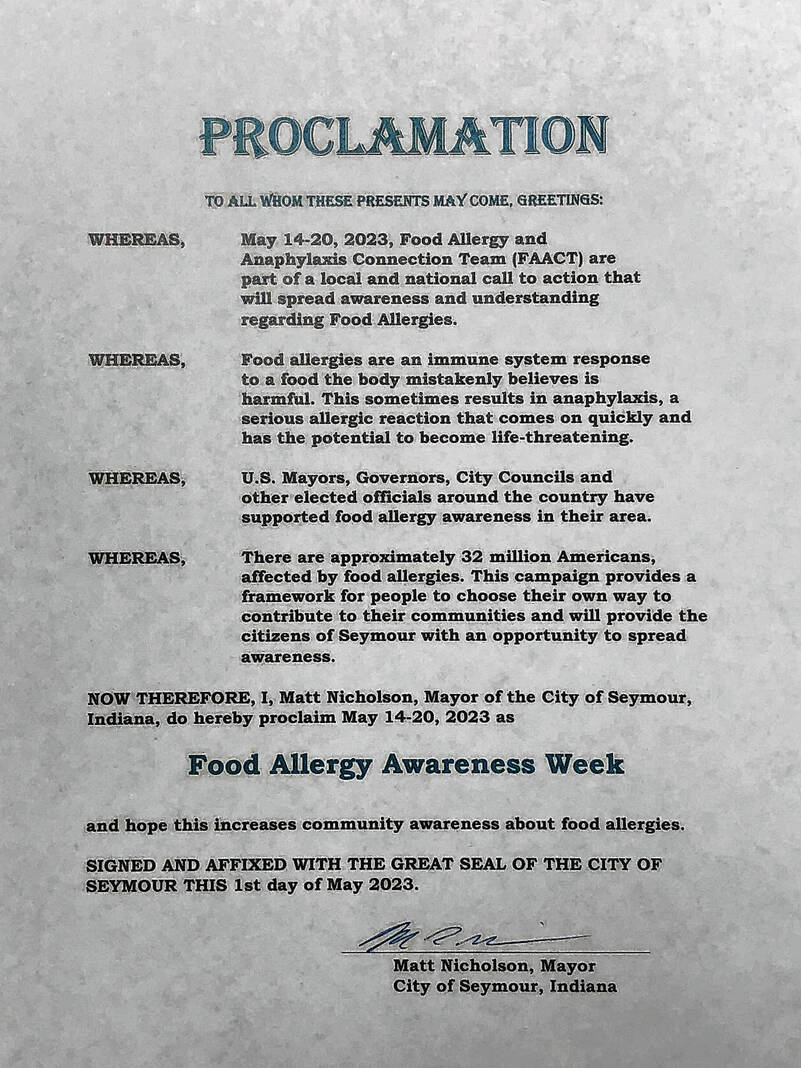More than 32 million Americans, including 26 million adults and 5.6 million children, are living with potentially life-threatening food allergies every day, according to foodallergy.org.
May is Food Allergy Awareness Month, providing a unique opportunity to educate others and help raise awareness of food allergies and anaphylaxis.
In an effort to increase food allergy awareness locally, Seymour Mayor Matt Nicholson has proclaimed May 14 to 20, 2023, as Food Allergy Awareness Week in Seymour.
Food allergies are a serious and potentially life-threatening medical condition, and one in every 13 children has a food allergy. That’s about two in every U.S. classroom, and every 3 minutes, a food allergy reaction sends someone to the emergency room, according to foodallergy.org.
Under the Americans with Disabilities Act, food allergies are usually considered disabilities. Students who have a food allergy are considered to have a disability, which restricts their diet.
What causes a food allergy?
The Food Allergy Research and Education website explains the job of the body’s immune system is to identify and destroy germs (such as bacteria or viruses) that make you sick. A food allergy happens when your immune system overreacts to a harmless food protein — an allergen.
Family history appears to play a role in whether someone develops a food allergy. If you have other kinds of allergic reactions such as eczema or hay fever you have a greater risk of food allergy. This also is true of asthma.
Food allergies are not the same as food intolerances, and food allergy symptoms overlap with symptoms of other medical conditions, so it is important to have a food allergy confirmed by an appropriate evaluation with an allergist.
Restaurants can reduce the risk
A study conducted by the Environmental Health Specialists Network found gaps in restaurant knowledge and practices about food allergies. Restaurants and environmental health programs can work to reduce the risk of customer food allergic reactions in their restaurant.
EHS-Net is a federally funded collaboration of federal, state and local environmental health specialists and epidemiologists working to better understand environmental causes of foodborne illness.
The study research showed how restaurants can take the following steps to prevent allergic reactions: Train staff on food allergies, especially less experienced staff; use separate equipment and areas to prepare and cook meals for customers with food allergies when feasible; provide ingredient lists or recipes for menu items; and have a plan for serving customers with food allergies.
What are the most frequent food allergens? Nine foods cause most food allergy reactions in the United States: Milk, egg, peanut, tree nut (for example, almonds, walnut, pecans, cashews, pistachios), wheat, sesame, soy, fish (for example, bass, flounder, cod) and shellfish (for example, crab, shrimp, scallop, clams).
Sesame is a rising food allergy and impacts an estimated 1 million people in the United States and was declared a major allergen in the United States in 2021, according to the Asthma and Allergy Foundation of America.
Food allergies are serious
Food allergy may occur in response to any food, and some people are allergic to more than one food. Allergies may start in childhood or as an adult.
All food allergies have one thing in common: They are potentially life-threatening. Always take food allergies — and the people who live with them — seriously.
Food allergy reactions can vary unpredictably from mild to severe. Mild food allergy reactions may involve only a few hives or minor abdominal pain, though some food allergy reactions progress to severe anaphylaxis with low blood pressure and loss of consciousness.
Currently, there is no cure for food allergies according to foodallergyawareness.org.
Desha Secrest, a primary care physician at Schneck Primary Care in Seymour, said food allergies can be very unpredictable, and someone may develop a severe reaction to a food they have eaten many times in the past without warning.
“Food allergies are a result of allergen-specific antibodies in the blood to food proteins,” she said. “Repeated exposure to the allergen may cause a process called sensitization that can lead to worsening symptoms over time.”
Secrest said an allergic reaction to food could range from a rash to much worse.
“Mild reactions range from gastrointestinal symptoms, such as nausea and diarrhea, to moderate symptoms of rash or hives to more severe reactions, such as airway inflammation, that that can be life-threatening,” she said.
She said since the level of allergy response can change over time, a patient with food allergies cannot assume their reactions will remain the same every time they are exposed to the offending food.
“A life-threatening allergy can develop without warning, so it is very important to be aware of the hidden foods, especially at a restaurant or pitch-in,” Secrest said. “Even small amounts of the food protein that may not be noticeable in the dish being eaten can trigger a response.”
Seek advice from a doctor
She said if someone suspects they might have a food allergy, they should seek the advice of his or her family physician as a starting point.
“For some patients, allergy testing can be very helpful to identify the offending foods and to determine if immunotherapy treatment may be beneficial,” Secrest said. “Your physician may also have helpful tips, including medication and avoidance. Medications such as Benadryl and an epinephrine pen on hand can be life-saving.”
Raise awareness by being a strong advocate and by teaching others about the dangers of food allergies and how to treat a potential reaction. Take a moment to thank friends, family members, teachers and other supportive people in your life for helping you and/or your child.
Websites for people with food allergies
foodallergy.org
kidswithfoodallergies.org
aafa.org
aaaai.org/conditions-treatments/allergies/food-allergy
allergyhome.org
foodallergyawareness.org
unileverfoodsolutions.us/chef-inspiration/allergen-101/5-food-allergy-guidelines-to-follow-in-your-restaurant.html




